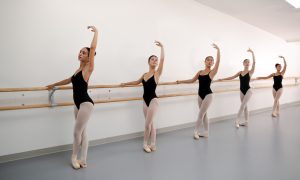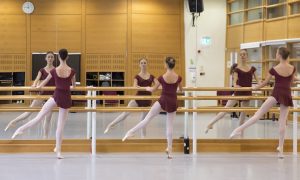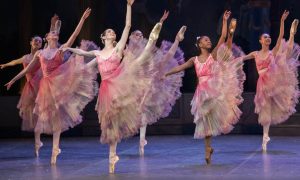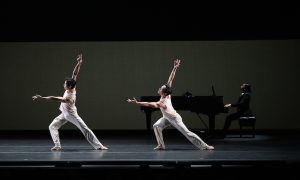By Emily Yewell Volin
Dance class environments are as diverse as the spectrum of dance genres. Many instructors adhere to a strict classical classroom protocol while others prefer a more relaxed atmosphere. Teaching requires enormous concentration. Student awareness of appropriate classroom etiquette helps the instructor stay on his or her preferred task; helping you to becoming the best dancer you can be.
Here are a few standard rules of dance class to help keep you on track:
Whenever possible arrive early to class and stretch independently. This is your time to warm up any areas of chronic pain and to prepare yourself for the business of dance class. Use this time to switch your focus from your daily concerns and prepare your body and mind for the rigors of class.
Demonstrate regard for the instructor and accompanist by standing as he/she enters the room. For ballet class, assume your position at the barre. Stand center floor for jazz, tap, modern and contemporary styles. It is typically fine to verbally greet the teacher and musician; however, keep it brief. This is their time to center their thoughts on goals for the class and to communicate these plans with each other. If the instructor and musician are already in the room when you arrive, be certain to stand (prepare) at the instructor’s first mention of beginning class.
It is customary to briefly inform the instructor of any injuries that prevent you from dancing full out during class time.
Be on time. Punctuality is paramount to your success in a class. The best advice for latecomers is to not enter class. However, if you find an instructor is patient with slight tardiness (no more than 5 minutes) you should wait at the doorway to see if the instructor makes eye contact with you. If yes; kindly ask if you may be allowed to join the class. If granted permission to enter, say ‘thank-you’ then quickly and silently assume an open position at the barre or center floor, depending on the class format. Apologize to both the instructor and the musician after class.
Adhere to dress code in footwear, clothing, and hair. Above all, appropriately support and cover your body. Nobody enjoys seeing more than we should of students and classmates during class time. Also realize dance clothes are fitted so that alignment and technique may be appropriately assessed and corrected. Be certain to remove all jewelry; it hurts having an earring pulled through its hole or to be scratched across the face by someone’s ring.
Wear deodorant and, when possible, come to class freshly showered.
Silence your mobile phone and do not ever text or take a call during class time.
Be quiet during class. There are generally moments of conversation during class. The general rule is that any conversation is initiated by the instructor.
Hold your placement throughout the class and allow your body the necessary time to rehearse its best alignment. Instructors format class to help your body warm up and align in a particular sequence. Slumping between center floor or the barre exercises will undo much of the progress you make during class time.
Center exercises and progressions are prime territory for lost class time. Pay attention so you know when to switch lines or when it’s your turn to feed into an across the floor sequence. Many instructors have zero tolerance for students who fail to keep up with this responsibility.
Listen and try to apply to every specific and general correction during class time.
Individual corrections are positive attention from your teacher. No matter how frustrated you may become, a simple ‘thank-you’ when the correction is given is always appreciated. Immediately try to apply the correction so the instructor may give additional guidance. A correction should only need to be given once, however mastering it may take longer. An experienced instructor can discern if you are trying to apply the correction. Maintaining a corrections journal helps many dancers organize their long term goals for specific classes.
Be sure to stand clear of the sight line between instructor and accompanist. They work as a team during class and must be able to see each other at all times.
Instruments are to be kept free of any debris and should never be used as physical support for the dancer. Be sure you do not ever place anything on top of a piano, drum set or other instrument. And yes; that includes your elbow.
Always dance port de bras full out, even when marking the rest of the movement.
Remain in your role as a student during class time. No matter how comfortable you feel with your classmates, do not offer corrections to them.
Do not take pictures or video during class time without the expressed permission of the teacher and students in the class. And; likewise, do not ever post class video or pictures to any social media site without first getting permission from the instructor, musician, and classmates.
Acknowledge the musician and instructor following révérence by applauding as a group and shaking hands or verbally thanking both the musician and instructor before your departure from the classroom.
Feel free to approach the instructor and/or accompanist after class regarding additional clarification or advice, but realize that he/she is probably on a schedule and very likely off to teach another class. Ask the instructor for an appropriate time to meet.
Following these basic rules of classroom etiquette will help maximize your artistic and technical growth during class. Individual instructors are likely to have additional guidelines for their class. If you are ever unsure about what to do, ask the instructor (after class).















